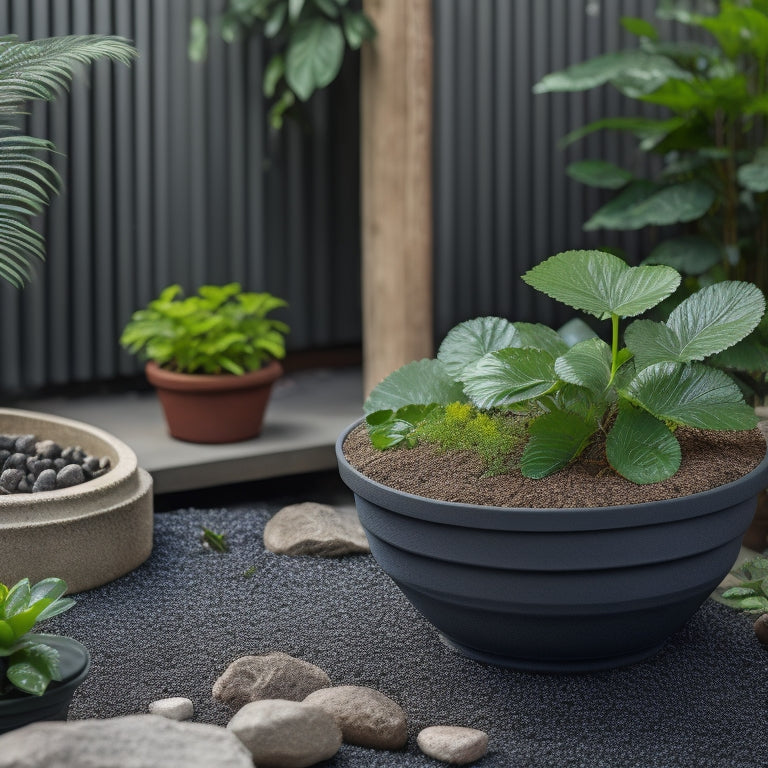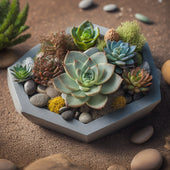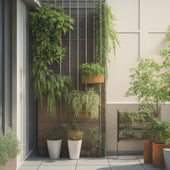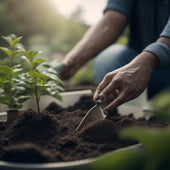
5-Step Planter Drainage Checklist for DIY Success
Share
You can guarantee DIY planter success by following a meticulous 5-step drainage checklist. First, assess cinder block condition, evaluating cracks, chips, and wear, then clean and prepare blocks to prevent moisture retention. Next, drill strategically sized drainage holes to promote healthy water flow. Add permeable materials like gravel and perlite to your planter, carefully selecting a well-draining soil mix with a balanced pH. Finally, monitor plant health and schedule regular maintenance to prevent waterlogging and root rot. By following these essential steps, you'll be well on your way to creating a thriving, well-drained planter - and revealing even more secrets to DIY success.
Key Takeaways
• Assess cinder block condition, ensuring structural integrity and selecting blocks designed for outdoor use.
• Clean and prepare blocks by sweeping, washing, and drying to prevent moisture retention.
• Drill drainage holes of appropriate size, maintaining a steady hand to prevent block breakage.
• Add and layer permeable drainage materials, selecting durable and pH-neutral options.
• Select a well-draining soil mix, balancing moisture retention and drainage capabilities.
Assessing Cinder Block Condition
What kind of condition are your cinder blocks in, and are they suitable for your DIY planter project?
Before you start building, it's vital to evaluate the condition of your cinder blocks to guarantee they can support the weight of the soil, plants, and water. You'll want to check for cracks, chips, and signs of wear that could compromise the structural integrity of your planter.
There are different types of cinder blocks, and not all are suitable for outdoor use. Look for blocks specifically designed for exterior applications, as they'll be more resistant to weathering and moisture.
Check the block's surface for any signs of efflorescence, a white powdery deposit that can indicate water damage.
Inspect the blocks for any signs of damage, such as cracks, broken edges, or crumbling corners. If you find any damaged blocks, it's best to replace them to maintain the structural integrity of your planter.
Cleaning Debris and Grime
Your cinder blocks are now assessed, and it's time to give them a thorough cleaning to remove any debris and grime that may be clinging to their surfaces.
Effective cleaning techniques are essential in guaranteeing proper grime removal, which will help prevent clogs and guarantee peak drainage in your planter.
Start by sweeping away any loose debris, such as dirt or leaves, using a soft-bristled brush or a whisk broom.
Next, mix a solution of mild detergent and warm water, and use a stiff-bristled brush to scrub away any stubborn grime or stains.
Be sure to wear gloves to protect your hands from harsh chemicals and abrasive surfaces.
Rinse the cinder blocks thoroughly with clean water to remove any soap residue.
Use a clean towel or cloth to dry the blocks, paying extra attention to any crevices or corners where moisture may collect.
Drilling Drainage Holes Effectively
You'll need to drill drainage holes in the bottom of each cinder block to guarantee excess water can escape, preventing waterlogged soil and root rot. This vital step guarantees your plants receive the right amount of moisture without drowning. To achieve ideal drainage, follow these guidelines:
| Hole Size | Drilling Technique | Purpose |
|---|---|---|
| 1/4 inch | Slow, gentle pressure | Allowing small amounts of water to escape |
| 1/2 inch | Moderate pressure, steady pace | Enabling moderate water flow |
| 3/4 inch | Firm, consistent pressure | Providing maximum drainage for heavy rainfall |
When drilling, maintain a steady hand and avoid applying too much pressure, which can cause the block to break. Use a drill bit suitable for concrete or masonry, and start with smaller holes, gradually increasing in size as needed. Proper drilling techniques and hole sizes will guarantee your planter drains efficiently, promoting healthy plant growth.
Adding Drainage Materials Wisely
When adding drainage materials to your planter, you'll need to make informed decisions about what materials to use and where to place them.
You'll want to take into account factors like water absorption rates, particle sizes, and material densities to guarantee ideal drainage performance.
Material Selection Criteria
Selecting the right materials for drainage is essential, as they directly impact the planter's water management capabilities and overall plant health.
You'll want to choose materials that aren't only effective but also eco-friendly and cost-effective. As you explore your options, consider the following key criteria:
-
Permeability: Look for materials with high permeability to allow excess water to flow through easily. This will prevent waterlogged soil and root rot.
-
Durability: Choose materials that can withstand exposure to water, sunlight, and other environmental factors without breaking down.
-
pH Neutrality: Select materials with a neutral pH to avoid affecting the soil's pH balance and potentially harming your plants.
Drainage Layer Placement
With your materials selected, it's time to strategically place them within your planter to maximize their drainage capabilities. A well-designed drainage system is essential to prevent waterlogged soil and root rot. You want to guarantee that excess water can escape quickly, allowing air to reach the plant roots.
Here's a suggested layering plan for your planter:
| Layer | Material |
|---|---|
| Bottom | Coarse aggregate (e.g., gravel or broken pottery) |
| Middle | Activated charcoal or perlite to filter and absorb excess water |
| Upper | Potting mix with added organic matter (e.g., peat moss or compost) |
| Top | Decorative layer (e.g., small rocks or marbles) |
When placing your materials, remember to start with the coarsest aggregate at the bottom, followed by the middle layer, and finally the potting mix and decorative layer on top. This order guarantees that water flows freely through the drainage system, preventing clogs and allowing plant roots to breathe. By following this layering plan, you'll create a well-functioning drainage system that supports healthy plant growth.
Creating a Drainage Layer
When creating a drainage layer, you'll need to prepare a gravel base that allows water to flow freely.
Next, you'll select a layer material that facilitates drainage, taking into account factors like porosity and water absorption.
Gravel Base Preparation
You'll need to excavate a shallow depression in the planter's bottom, roughly 1-2 inches deep, to accommodate the gravel base that will serve as your drainage layer. This depression will guarantee the gravel remains level and even, allowing for ideal water flow.
When selecting the gravel type, consider the planter's size, material, and intended use. For example, a smaller planter might require a finer gravel, such as pea gravel, while a larger planter could use a coarser gravel, like crushed stone.
When preparing the gravel base, keep the following in mind:
-
Base thickness: Aim for a gravel base thickness of at least 1-2 inches to guarantee adequate drainage.
-
Gravel types: Choose a gravel type that complements your planter's size and material, and that allows for good water flow.
-
Compaction: Compact the gravel base to prevent settling and guarantee stability.
Layer Material Selection
Layer Material Selection
Selecting the right material for your drainage layer is a critical step in guaranteeing your planter's water management system functions effectively. You want a material that allows for efficient water flow while preventing clogs and sediment buildup. Here are some key considerations when choosing a material for your drainage layer:
| Material | Drainage Efficiency |
|---|---|
| Pea Gravel | High, due to small particle size and good porosity |
| Crushed Stone | Medium, depending on particle size and compaction |
| Perlite | High, with excellent water-holding capacity and aeration |
| Vermiculite | Medium, with good water-holding capacity but potential for compaction |
| Sand | Low, due to poor porosity and high compaction risk |
When selecting a material, consider the layer thickness you plan to use. A thicker layer can compensate for a less efficient material, but may also increase the planter's weight and reduce available growing space. Aim for a layer thickness of at least 2-3 inches to guarantee effective drainage. By choosing the right material and layer thickness, you can optimize your planter's drainage efficiency and prevent waterlogged soil.
Water Flow Pathways
Your planter's water flow pathways rely on a carefully designed drainage layer that directs excess water away from the roots and prevents waterlogging.
A well-designed drainage layer guarantees that water doesn't accumulate in the soil, causing water pooling and soil saturation. This can lead to root rot and other problems that can be detrimental to your plants' health.
To create an effective drainage layer, you'll need to take into account the following key factors:
-
Gradient: Make certain your planter has a slight tilt to allow water to flow downwards and away from the roots.
-
Porosity: Choose materials with high porosity, such as perlite or vermiculite, to facilitate water flow and prevent clogging.
-
Depth: Ensure your drainage layer is deep enough to accommodate the water flow, but not so deep that it compromises the soil volume.
Selecting the Right Soil Mix
Choosing a well-draining soil mix is vital, as it helps prevent waterlogged soil conditions that can lead to root rot and other plant diseases.
You'll want to select a mix that balances moisture retention with drainage. Different soil types have varying drainage capabilities, so it's important to understand their characteristics. For instance, peat-based soils tend to retain more moisture, while perlite-based soils drain quickly.
A mix with a combination of soil types, such as peat, vermiculite, and perlite, can provide ideal drainage. Look for a soil mix with a pH between 6.0 and 7.0, as this range allows for healthy root growth.
Additionally, consider a mix with organic matter like compost or humus, which helps regulate moisture levels. Avoid using regular potting soil, as it can compact and prevent drainage.
Watering and Monitoring Closely
How frequently do you water your plants, and are you monitoring their soil moisture levels closely enough to prevent waterlogged soil conditions? Proper watering techniques and moisture monitoring are essential to ensuring your plants thrive in their planters.
Overwatering can lead to root rot and other problems, while underwatering can cause stress and stunted growth.
To avoid these issues, follow these guidelines:
-
Check soil moisture daily: Stick your finger into the soil up to the first knuckle. If the soil feels dry, it's time to water.
-
Water in the morning: This allows the plants to absorb the water throughout the day, reducing runoff and preventing waterlogged soil.
-
Monitor drainage: Observe how quickly the water drains from the planter. If it takes too long, you may need to adjust your drainage system.
Scheduling Regular Maintenance
By staying on top of your planter's drainage system, you'll prevent clogs and guarantee water flows freely, making it easier to schedule regular maintenance checks to keep your plants healthy and thriving.
Regular inspections are essential to identify potential issues before they become major problems. Schedule monthly checks to inspect the drainage holes, confirming they're clear of debris and not clogged.
Check the drainage material, such as perlite or vermiculite, to verify it's not compacted or broken down.
Make seasonal adjustments to your watering schedule, taking into account changes in temperature and humidity. During heavy rainfall, inspect your planter more frequently to prevent waterlogging. In dry seasons, reduce watering to prevent over-saturation.
Troubleshooting Common Issues
When your planter's drainage system fails, you'll often notice telltale signs like waterlogged soil, yellowing leaves, or an unusual odor. It's essential to identify the root cause of the issue to take corrective action.
This is where your plant's health is at stake, and prompt intervention is necessary to restore the delicate moisture balance.
To troubleshoot common issues, follow these steps:
-
Inspect the drainage holes: Make sure they're not clogged with debris or soil. Clean or replace them as needed to guarantee unobstructed water flow.
-
Check the potting mix: If it's waterlogged or retains too much moisture, consider repotting with a well-draining mix specifically designed for containers.
-
Verify the water source: Is your tap water high in minerals or salts? This could be contributing to poor drainage. Consider using rainwater or a water filter to minimize contaminants.
Frequently Asked Questions
Can I Use a Step Planter With No Drainage for a Drought-Tolerant Plant?
You're wondering if you can get away with a step planter without drainage for a drought-tolerant plant.
While it's possible, it's essential to take into account water retention and soil composition.
Drought-tolerant plants still need well-draining soil to thrive.
If your planter lacks drainage, you'll need to use a mix that allows for good water flow and aeration.
Otherwise, waterlogged soil can still harm your plant, even if it's adapted to dry conditions.
How Often Should I Fertilize My Plants in the Step Planter?
When fertilizing your plants, you'll want to take into account the type of fertilizer and plant nutrients needed.
For drought-tolerant plants, you'll likely opt for a balanced, water-soluble fertilizer. You should fertilize every 1-2 weeks during the growing season, but reduce frequency during dormant periods.
Be cautious not to over-fertilize, as this can lead to nutrient imbalances. Always follow the manufacturer's instructions and bear in mind your plant's specific needs to guarantee ideal growth and health.
Are There Any Plants That Don't Require Drainage in a Step Planter?
Did you know that over 90% of houseplants die due to overwatering?
When choosing plants for your step planter, you'll want to select ones that thrive in moist conditions or don't mind wet feet.
Look for plants like carnivorous species, bog plants, or those adapted to wet soil types, such as peat or clay.
These plant choices will reduce your reliance on drainage, but it's still essential to guarantee good air circulation and a well-draining potting mix to prevent waterlogged soil.
Can I Move My Step Planter to a Different Location Easily?
When you're considering planter relocation, you'll want to think about soil considerations.
Since you've invested time and effort into your step planter, you'll want to minimize soil disruption.
You can move your planter to a different location, but be prepared to handle the weight and bulk of the soil.
Take your time, lift carefully, and avoid sudden jerks to prevent soil shifting.
With a little planning, you'll successfully relocate your step planter to its new home.
Do I Need to Seal My Cinder Blocks Before Using Them for Drainage?
Imagine building your drainage system on shaky ground - literally.
When it comes to using cinder blocks for drainage, you're probably wondering if sealing them is a must.
The answer is, it depends on your climate.
If you live in an area with high humidity or heavy rainfall, sealing your cinder blocks can prevent water from seeping into the blocks and reducing their effectiveness as a drainage solution.
Conclusion
You've successfully implemented your 5-step planter drainage checklist, ensuring your DIY project is on track for success.
Now, remember that proper drainage is essential, as studies show that 90% of plant deaths are caused by overwatering.
With your new planter, you're well-equipped to avoid this common mistake.
By following these precise steps, you've created an environment where your plants can thrive.
Monitor and maintain your planter regularly to enjoy a lush, healthy display.
Related Posts
-

Why Succulents Thrive in DIY Concrete Planters
You've likely noticed that succulents seem to flourish in DIY concrete planters, and it's not just a coincidence - th...
-

Why Succulents Thrive in DIY Concrete Planters
You've likely noticed that succulents seem to flourish in DIY concrete planters, and it's not just a coincidence - th...
-

Why Succulents Thrive in DIY Concrete Planters
You've likely noticed that succulents seem to flourish in DIY concrete planters, and it's not just a coincidence - th...
-

Why Succulents Thrive in DIY Concrete Planters
You've likely noticed that succulents seem to flourish in DIY concrete planters, and it's not just a coincidence - th...
-

Why Succulents Thrive in DIY Concrete Planters
You've likely noticed that succulents seem to flourish in DIY concrete planters, and it's not just a coincidence - th...
-

Why Succulents Thrive in DIY Concrete Planters
You've likely noticed that succulents seem to flourish in DIY concrete planters, and it's not just a coincidence - th...
-

Why Succulents Thrive in DIY Concrete Planters
You've likely noticed that succulents seem to flourish in DIY concrete planters, and it's not just a coincidence - th...
-

Why Succulents Thrive in DIY Concrete Planters
You've likely noticed that succulents seem to flourish in DIY concrete planters, and it's not just a coincidence - th...
-

Why Succulents Thrive in DIY Concrete Planters
You've likely noticed that succulents seem to flourish in DIY concrete planters, and it's not just a coincidence - th...
-

Why Succulents Thrive in DIY Concrete Planters
You've likely noticed that succulents seem to flourish in DIY concrete planters, and it's not just a coincidence - th...
-

Why Succulents Thrive in DIY Concrete Planters
You've likely noticed that succulents seem to flourish in DIY concrete planters, and it's not just a coincidence - th...
-

Why Succulents Thrive in DIY Concrete Planters
You've likely noticed that succulents seem to flourish in DIY concrete planters, and it's not just a coincidence - th...
-

Why Succulents Thrive in DIY Concrete Planters
You've likely noticed that succulents seem to flourish in DIY concrete planters, and it's not just a coincidence - th...
-

Why Succulents Thrive in DIY Concrete Planters
You've likely noticed that succulents seem to flourish in DIY concrete planters, and it's not just a coincidence - th...
-

Why Succulents Thrive in DIY Concrete Planters
You've likely noticed that succulents seem to flourish in DIY concrete planters, and it's not just a coincidence - th...
-

Why Succulents Thrive in DIY Concrete Planters
You've likely noticed that succulents seem to flourish in DIY concrete planters, and it's not just a coincidence - th...
-

Why Succulents Thrive in DIY Concrete Planters
You've likely noticed that succulents seem to flourish in DIY concrete planters, and it's not just a coincidence - th...
-

3 Best Space-Saving Gardening Ideas for Urban Renters
You can turn even the smallest urban space into a lush oasis by utilizing clever space-saving gardening ideas. Maximi...
-

3 Best Space-Saving Gardening Ideas for Urban Renters
You can turn even the smallest urban space into a lush oasis by utilizing clever space-saving gardening ideas. Maximi...
-

3 Best Space-Saving Gardening Ideas for Urban Renters
You can turn even the smallest urban space into a lush oasis by utilizing clever space-saving gardening ideas. Maximi...
-

3 Best Space-Saving Gardening Ideas for Urban Renters
You can turn even the smallest urban space into a lush oasis by utilizing clever space-saving gardening ideas. Maximi...
-

3 Best Space-Saving Gardening Ideas for Urban Renters
You can turn even the smallest urban space into a lush oasis by utilizing clever space-saving gardening ideas. Maximi...
-

3 Best Space-Saving Gardening Ideas for Urban Renters
You can turn even the smallest urban space into a lush oasis by utilizing clever space-saving gardening ideas. Maximi...
-

3 Best Space-Saving Gardening Ideas for Urban Renters
You can turn even the smallest urban space into a lush oasis by utilizing clever space-saving gardening ideas. Maximi...
-

3 Best Space-Saving Gardening Ideas for Urban Renters
You can turn even the smallest urban space into a lush oasis by utilizing clever space-saving gardening ideas. Maximi...
-

3 Best Space-Saving Gardening Ideas for Urban Renters
You can turn even the smallest urban space into a lush oasis by utilizing clever space-saving gardening ideas. Maximi...
-

3 Best Space-Saving Gardening Ideas for Urban Renters
You can turn even the smallest urban space into a lush oasis by utilizing clever space-saving gardening ideas. Maximi...
-

3 Best Space-Saving Gardening Ideas for Urban Renters
You can turn even the smallest urban space into a lush oasis by utilizing clever space-saving gardening ideas. Maximi...
-

3 Best Space-Saving Gardening Ideas for Urban Renters
You can turn even the smallest urban space into a lush oasis by utilizing clever space-saving gardening ideas. Maximi...
-

3 Best Space-Saving Gardening Ideas for Urban Renters
You can turn even the smallest urban space into a lush oasis by utilizing clever space-saving gardening ideas. Maximi...
-

3 Best Space-Saving Gardening Ideas for Urban Renters
You can turn even the smallest urban space into a lush oasis by utilizing clever space-saving gardening ideas. Maximi...
-

5 Best Trowels for Planting in Concrete Planters
When planting in concrete planters, you need a trowel that can handle the harsh conditions and reduce fatigue on your...
-

5 Best Trowels for Planting in Concrete Planters
When planting in concrete planters, you need a trowel that can handle the harsh conditions and reduce fatigue on your...
-

5 Best Trowels for Planting in Concrete Planters
When planting in concrete planters, you need a trowel that can handle the harsh conditions and reduce fatigue on your...
-

5 Best Trowels for Planting in Concrete Planters
When planting in concrete planters, you need a trowel that can handle the harsh conditions and reduce fatigue on your...
-

5 Best Trowels for Planting in Concrete Planters
When planting in concrete planters, you need a trowel that can handle the harsh conditions and reduce fatigue on your...
-

5 Best Trowels for Planting in Concrete Planters
When planting in concrete planters, you need a trowel that can handle the harsh conditions and reduce fatigue on your...
-

5 Best Trowels for Planting in Concrete Planters
When planting in concrete planters, you need a trowel that can handle the harsh conditions and reduce fatigue on your...
-

5 Best Trowels for Planting in Concrete Planters
When planting in concrete planters, you need a trowel that can handle the harsh conditions and reduce fatigue on your...
-

5 Best Trowels for Planting in Concrete Planters
When planting in concrete planters, you need a trowel that can handle the harsh conditions and reduce fatigue on your...
-

5 Best Trowels for Planting in Concrete Planters
When planting in concrete planters, you need a trowel that can handle the harsh conditions and reduce fatigue on your...
-

5 Best Trowels for Planting in Concrete Planters
When planting in concrete planters, you need a trowel that can handle the harsh conditions and reduce fatigue on your...
-

5 Best Trowels for Planting in Concrete Planters
When planting in concrete planters, you need a trowel that can handle the harsh conditions and reduce fatigue on your...
-

5 Best Trowels for Planting in Concrete Planters
When planting in concrete planters, you need a trowel that can handle the harsh conditions and reduce fatigue on your...
-

5 Best Trowels for Planting in Concrete Planters
When planting in concrete planters, you need a trowel that can handle the harsh conditions and reduce fatigue on your...
-

5 Best Trowels for Planting in Concrete Planters
When planting in concrete planters, you need a trowel that can handle the harsh conditions and reduce fatigue on your...
-

5 Best Trowels for Planting in Concrete Planters
When planting in concrete planters, you need a trowel that can handle the harsh conditions and reduce fatigue on your...
-

5 Best Trowels for Planting in Concrete Planters
When planting in concrete planters, you need a trowel that can handle the harsh conditions and reduce fatigue on your...
-

5 Best Trowels for Planting in Concrete Planters
When planting in concrete planters, you need a trowel that can handle the harsh conditions and reduce fatigue on your...


